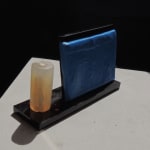Neo-Elamite Chalcedony Cylinder Seal, 800 BCE - 600 BCE
Chalcedony
1.08
AM.0159
Further images
The Elamite Empire was on of the world’s most important and influential ancient cultures. The empire itself was founded in around 3200 BC, and it lasted – in various guises...
The Elamite Empire was on of the world’s most important and influential ancient cultures. The empire itself was founded in around 3200 BC, and it lasted – in various guises – almost continuously until the mid first millennium BC; much of its history is also documented using the world’s earliest deciphered alphabet, which makes it of extraordinary value to historians and archaeologists. The earliest phases are somewhat unclear. The most extensively researched periods starts with the Old Elamite Period (OEP), which began around 2700 BC and saw the conquest of Elam by Enmebaragesi of Kish. Lists of kings indicate a temporary domination of Sumer (Iraq) by later dynasties within the OEP, although Elam was briefly dominated by strong Sumerian rulers. Struggles with the Akkadians and repeated conquests in both directions characterised much of the Avan Dynasty; diplomatic relations between the Sumer and Elam improved, but perhaps only because the former’s power was waning. The Elamites sacked Ur in 2004 BC, and led Ibbi Sin into captivity. Later dynasties in the OEP saw burgeoning power structures throughout the Elamite Empire, leading to the rise of the Anshanite dynasties around 1500 BC and the arrival of the Middle Elamite Period (MEP). Akkadian influence waned during this period, and Elamite gained strength; Elamite influence likewise burgeoned, capturing and sacking cities and artworks from the Babylonians and other neighbours. The power of the empire waned dramatically towards the end of the MEP with the inbred king Khutelutush-In- Shushinak, who was the product of his father and sister. Under his unsteady rule, the Elamite Empire fell into obscurity for almost three centuries, allowing their foes to reclaim their territory and plunder. The rise of the Neo- Elamite period is little understood, but in time the empire gained its former strength. It is to this time that the current seal pertains. When developed the carving shows a stylized sacred tree in the middle of a scene, with standing composite creature on each side. These creatures have a bearded human head, wings and the body and horns of an ibex. A five-line inscription in Neo-Elamite cuneiform gives the name and father's name of the ancient owner: Shamash-kin, son of Umbun. The owner's name is a somewhat rare Babylonian name, but the father bores an Elamite name.
The seal is a fine work on a small scale, and in a very good state of preservation. Chalcedony is a microcrystalline type of quartz, occurring in a number of varieties, which include onyx and agate; it has a waxy luster, and may be semitransparent or translucent. It can assume a wide range of colors, but those most commonly seen are white to gray, grayish-blue or a shade of brown ranging from pale to nearly black.
The seal is a fine work on a small scale, and in a very good state of preservation. Chalcedony is a microcrystalline type of quartz, occurring in a number of varieties, which include onyx and agate; it has a waxy luster, and may be semitransparent or translucent. It can assume a wide range of colors, but those most commonly seen are white to gray, grayish-blue or a shade of brown ranging from pale to nearly black.





